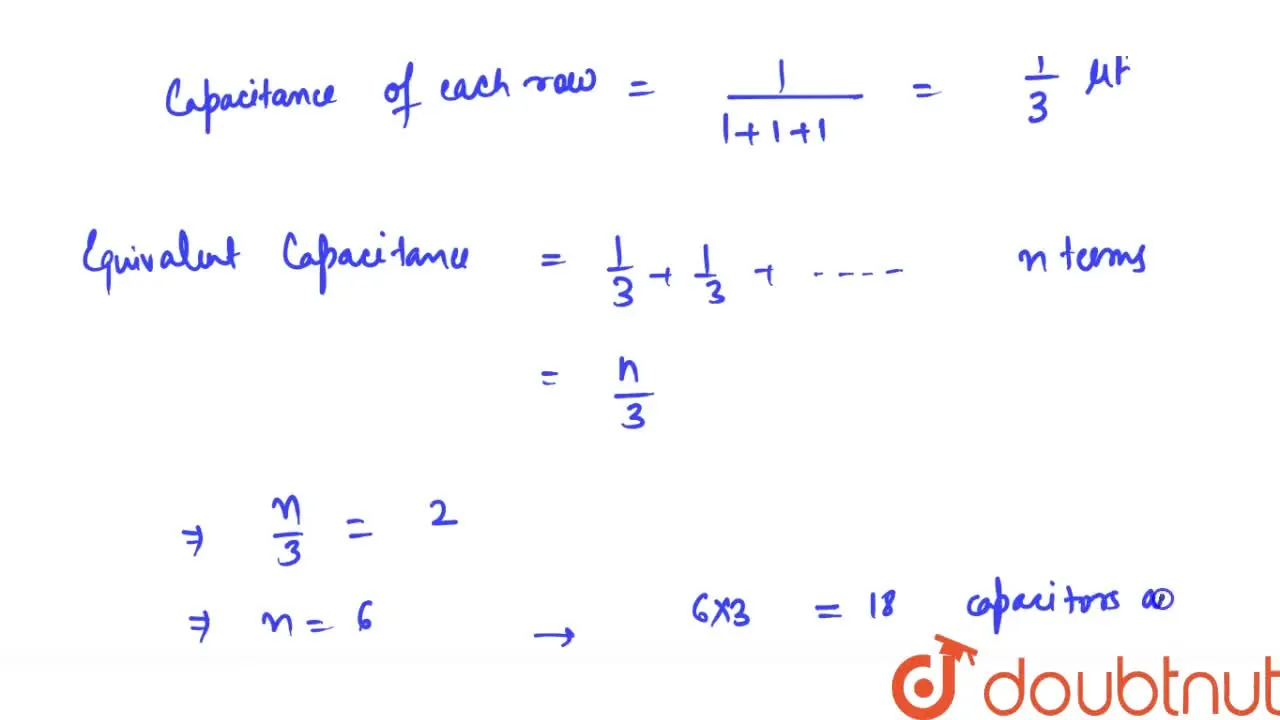An electrical technician requires a capacitance of 2μF in a circuit across a potential difference of 1 kV. A large number of 1μF capacitors are available to him each of which can withstand a potential difference of not more than 400 V. Suggest a possible arrangement that requires the minimum number of capacitors.
Here. Total capacitance, C=2μF,
Potential difference, V=1kV=1000volt
Capacity of each capacitor, C1=1μF,
Maximum potential difference across each.
V'=400volt
Let n capacitors fo 1μF each be connected in series in a row and m such rows be connected in parallel as shown in Fig.
As potential difference acoross each row = 1000 volt
∴ Potential difference across each capacitors =1000n=V'=400
∴n=1000400=2.5
As n has to be a whole number (not less than 2.5), therefore , n=3.
Capacitance of each row of 3 conderes of 11μF each, in series =1/3.
Total capacitance of m such rows in parallel =m3∴m3=2(μF)orm=6
∴ total number capacitors =n×m=3×6=18
Hence 1μF capacitors should be connected in six parallel rows, each row contaning three capacitors in series.

Related Playlists
- BOOK - PRADEEPCHAPTER - ELECTROSTATICSEXERCISE - ADDITIONAL QUESTIONS2videos
ELECTROSTATICS
- BOOK - PRADEEPCHAPTER - ELECTROSTATICSEXERCISE - LONG ANSWER QUESTIONS8videos
ELECTROSTATICS
- BOOK - PRADEEPCHAPTER - ELECTROSTATICSEXERCISE - ADVANCED PROBLEMS FOR COMPETITIONS1videos
ELECTROSTATICS
- BOOK - PRADEEPCHAPTER - ELECTRONIC DEVICESEXERCISE - Fill in the Blanks1videos
ELECTRONIC DEVICES
- BOOK - PRADEEPCHAPTER - MAGNETIC EFFECT OF CURRENT AND MAGNETISMEXERCISE - Competition Focus (Multiple Choice Questions)2videos
MAGNETIC EFFECT OF CURRENT AND MAGNETISM
Similar Questions
An electrical technician requires a capacitance of 2 uF in a circuit across a potential difference of 1 kV. A large number of 1 uF capacitors are available to him each of which can withstand a potential difference of not more than 400 V. Suggest a possible arrangement that requires the minimum number of capacitors.
View SolutionAn electrical technician requires a capacitance of 2μF in a circuit across a potential difference of 1 kV. A large number of 1μF capacitors are available to him each of which can withstand a potential difference of not more than 400 V. Suggest a possible arrangement that requires the minimum number of capacitors.
View SolutionA student requires a capacitor of 3μF in a circuit across a potential of 1000 V. A large number of 2μF capacitors are available to him, each of which can withstand a potential difference of not more than 300 V. How should the student arrange these capacitors so that he may use minimum number of condensers ?
View SolutionA capacitance of 2μF is required in an electrical circuit across a potential difference of 1.0kV A large number of 1μF capacitors are available which can withstand a potential difference of not more than 300v.
The minimum number of capacitors required to achieve this isView SolutionA capacitance of 2μF is required in an electrical circuit across a potential difference of 1.0kV A large number of 1μF capacitors are available which can withstand a potential difference of not more than 300v.
The minimum number of capacitors required to achieve this isView SolutionAn electric circuit requires a total capacitance of 2μF across a potential of 1000V. Large number of 1μF capacitances are available each of which would breakdown if the potential is more than 350 V. How many capacitances are required to mae the circuit ?
View SolutionWhile working on a physics project at school physics, lab, you require a 4 μF capacitor in a circuit across a potential difference of 1 k V. Unfortunately, 4 μF capacitors are out or stock in your lab but 2 μF capacitors which can withstand a potential difference of 400 V are available in plenty . if you decide to use the 2 μF capacitors in place of 4μ F capacitor minimum number of capacitors required are
View SolutionWhile working on a physics project at school physics lab, you required 4μF capacitor in a circuit across a potential difference of 1 kV. Unfortunately, 4μF capacitors are out of stock in your lab but 2μF capacitors which can withstand a potential difference of 400 V are available in plenty . If you decide to use the 2μF capacitors in place of 4μF capacitor , minimum number of capacitors required are
View SolutionIn the arrangement shown, a potential difference is applied between points A and B. No capacitor can withstand a potential difference of more than 100 V
 View Solution
View SolutionTwo capacitors of capacitances 10μFand20μF are connected in series across a potential difference of 100V. The potential difference across each capacitor is respectively
View Solution


